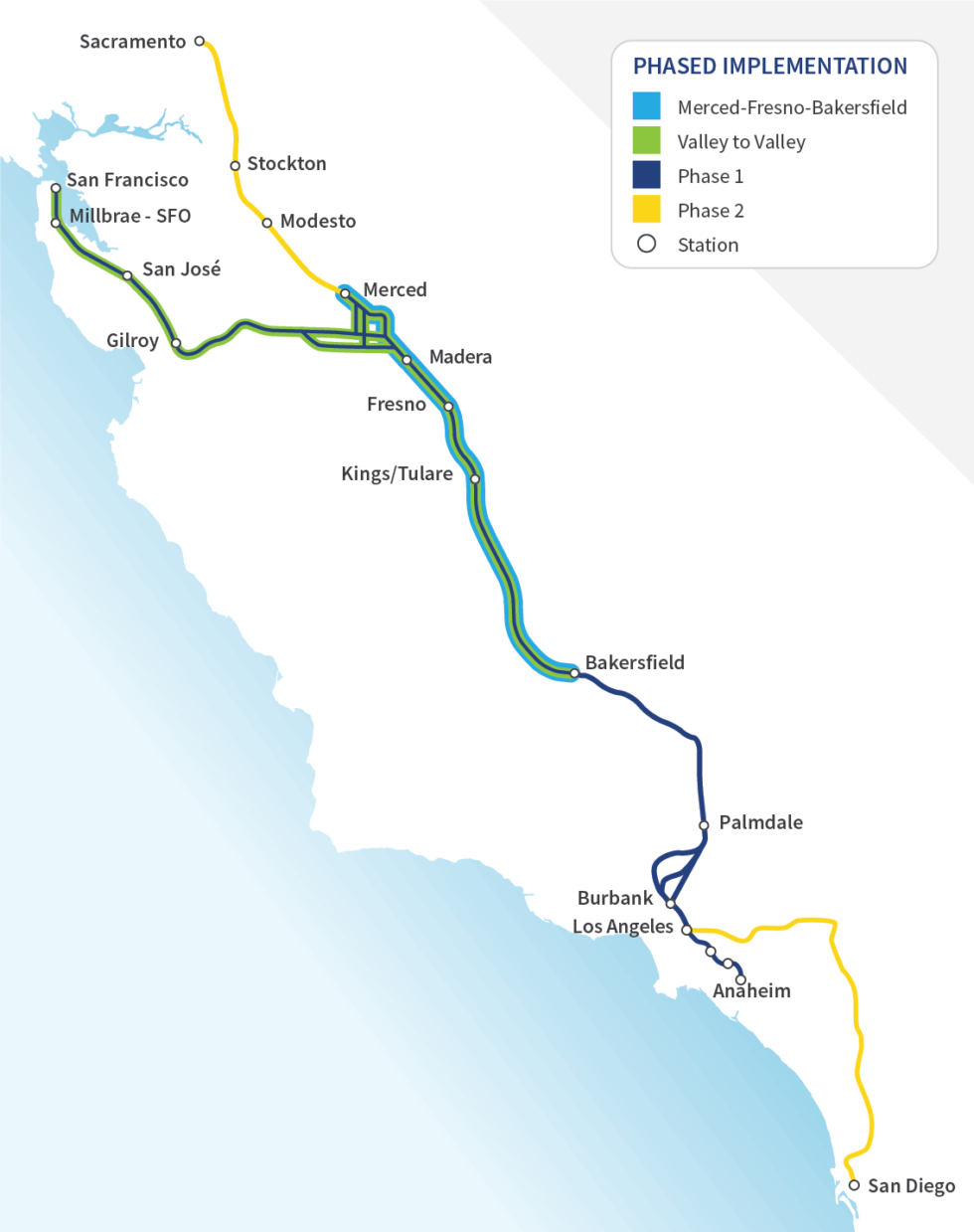

San Francisco, San Jose, Los Angeles and San Diego are each in the process of significantly expanding their local rapid transit systems in a manner that will make them compatible with local high-speed rail stations. By passing the $9.5 billion referendum in 2008, state voters indicated that they were willing to put a very substantial chunk of their own money, not just federal funds, on the line for an investment that will truly offer an alternative to automobile and aviation travel in this state. What is so exciting about California’s project is the initiative the state and its municipalities have taken in the advancement of a program that could - if the public so desires - alter permanently the geography of America’s most populous state. Credit: California High-Speed Rail Authority Map of the initial plans for service along the California High-Speed Rail route, showing the Madera-Bakersfield segment. It should be criticized and improved, but its weak points should not be Achilles’ heels. Does an imperfect project deserve to be abandoned? I think not. But we live in a democracy where our elected officials, not engineers, make final decisions about projects such as this. Its creation and development have been the result of compromise and negotiation between political leaders whose interests do not necessarily coincide with the ideal investment. The high-speed rail project is quite expensive and it is not perfect. Avoiding Fresno may have made building any high-speed rail impossible. Without support from some residents and politicians in the Central Valley, the program could not have been passed either in 2008 or last week. More importantly, though, California’s rail project is a statewide program about more than people from the coast. Because they currently do not have good airline service, they stand to be some of the places that benefit most from the project. and San Francisco as quickly as possible, the project could have been built to run around Interstate-5, which charts a slightly straighter route through the Central Valley - not doing so, the Los Angeles Times told us today, could be a major flaw in the project.** But that alignment would skip over the Central Valley’s cities, depriving them of the direct access to California’s biggest regions. If the only goal of the project were to connect L.A. It is the only section of the system where sustained speeds of 220 mph can be offered by trains cruising down the straight-aways through farmlands.Īnd it can be done at the moderate cost of about $44 million per mile, in a similar range as projects such as France’s LGV Sud-Europe Atlantique, now under construction (211 miles at a cost of €6.2 billion, or $7.6 billion, so about $36 million per mile). Basin, has induced the expected calls of a “railway to nowhere.” Yet the route selected in fact serves an area with a population of 3 million people and offers the crucial link between the two large metropolitan areas to the north and south. Choosing to begin construction in the Central Valley, away from the population centers of the Bay Area and L.A. The line section that will be built first has not been without controversy. Moreover, it is a victory for those who argue that, despite the challenges and the compromises, in order to advance societal change on a grand scale, major investments in projects such as this are necessary. Jerry Brown and California’s Democratic Party (no Republicans in either chamber voted in favor of the program), but also for President Obama and his Department of Transportation, which have championed high-speed rail as an essential element of America’s future transportation system. The passage of the bill, which also frees up $3.2 billion in federal funds allocated for the project, is a major success not only for Gov. Tracks between the cities Madera and Bakersfield could be ready for use by 2017, the first step toward what could be an eventual 2-hour, 40-minute journey time for trains traveling from downtown San Francisco to Los Angeles. On Friday, by a vote of 21 to 16, the State Senate expressed its agreement.* If all goes as planned, the project could be under construction by the beginning of next year. On Thursday, California’s State Assembly approved by a 51 to 27 margin the release of $2.5 billion in state bonds for the construction of a 130-mile segment of 220-mph tracks through the Central Valley and the implementation of $2 billion in commuter rail improvements in the Bay Area and Los Angeles regions. Last week, America’s future in high-speed rail took a modest step forward.


 0 kommentar(er)
0 kommentar(er)
